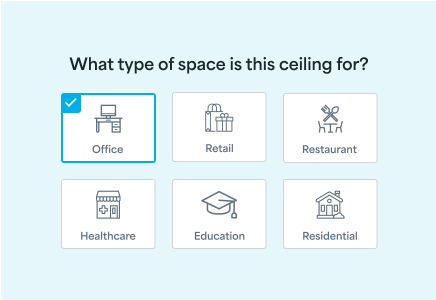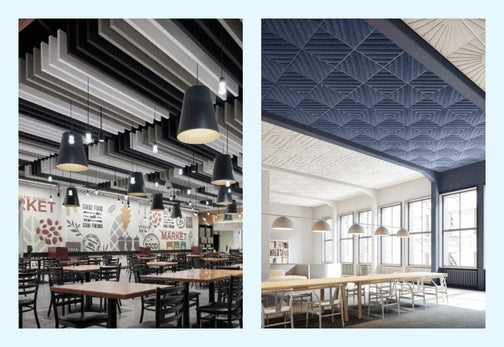Office ceiling tiles: A complete guide for improving your workspace

When designing an office, ceiling tiles are often overlooked, but they play a crucial role in creating a comfortable, aesthetically pleasing, and functional workspace. Whether you're renovating an existing office or setting up a new one, ceiling tiles can significantly impact noise control, lighting, and the overall ambiance of your office. In this guide, we'll explore the different types of office ceiling tiles, their benefits, and how to choose the right option for your needs.
Benefits of office ceiling tiles
Office ceiling tiles are popular for several reasons:
-
Acoustic control: Ceiling tiles help manage noise levels in office spaces. Tiles made from sound-absorbing materials can reduce echo and improve privacy, leading to a quieter and more productive environment.
-
Aesthetic appeal: They enhance the look of the office by providing a finished, polished ceiling that can fit different interior design styles, from modern to traditional.
-
Lighting optimization: Reflective ceiling tiles can improve lighting by distributing light evenly throughout the office, reducing the need for excessive lighting fixtures.
-
Concealing infrastructure: Drop ceiling tiles effectively hide unsightly ducts, wires, and pipes while allowing easy access when maintenance is required.
-
Temperature regulation: Tiles with TEMPLOK phase change material (PCM) technology can contribute to maintaining a comfortable indoor temperature and help to reduce energy cost and usage.
Types of office ceiling tiles
Choosing the right ceiling tiles depends on the specific needs of your office. Here are the common types:
-
Acoustic ceiling tiles: Designed to absorb sound, these tiles are perfect for open-plan offices, conference rooms, or call centers where noise reduction is critical.
-
Mineral fiber ceiling tiles: These are among the most common options. Made from a mixture of renewable and natural materials including starch, perlite, and clay they offer good sound absorption and blocking, along with fire resistance.
-
PVC and vinyl-coated tiles: Ideal for offices that need to meet hygiene standards, such as medical or lab environments. They are easy to clean and resistant to moisture.
-
Faux wood ceiling tiles: For a sophisticated and warm aesthetic, wood finish planks and tiles provide a high-end look. They are great for executive offices and reception areas and are less expensive than real wood.
-
Metal ceiling tiles: These tiles, typically made from aluminum or steel, offer a sleek, modern look and are highly durable. They’re perfect for a contemporary office aesthetic.
-
Fiberglass ceiling tiles: Lightweight and effective at sound insulation, these tiles are suitable for spaces that need enhanced acoustic properties.
Choosing the right ceiling tiles for your office
Here are a few factors to consider when choosing ceiling tiles:
-
Acoustic needs: If your office is an open-plan space, noise reduction should be a priority. Acoustic tiles can help reduce the noise and improve productivity.
-
Aesthetics: The visual appeal of ceiling tiles matters for the ambiance of your office. Sleek metal tiles might work for a modern tech company, while wood tiles could enhance a law firm's prestigious atmosphere.
-
Budget: Cost is always a consideration. Mineral fiber tiles are budget-friendly, whereas wood or specialty tiles will require a higher investment.
-
Maintenance: Consider how easy it is to clean and maintain the tiles. Vinyl-coated tiles are easy to wipe down, making them suitable for environments requiring high cleanliness.
-
Fire resistance: Depending on the building codes, you may need to install fire-resistant ceiling tiles for safety purposes.
Ceiling tile installation considerations
Most office ceiling tiles are installed as part of a drop ceiling system. Here are some key installation points:
-
Suspended grid system: Tiles are typically installed in a grid that is suspended from the ceiling, creating space for utilities. Ensure the structure is securely fixed to avoid sagging over time.
-
Accessibility: When planning the ceiling layout, consider the placement of lighting fixtures, air vents, and access panels to make maintenance tasks easier.
-
Professional installation: While it's possible to install ceiling tiles as a DIY project, professional installation is recommended to ensure safety and alignment, especially in larger office spaces.
Office ceiling tile design ideas
Here are some popular design ideas for office ceiling tiles:
-
Mix-and-match patterns: Use different patterns or colors to create zones within the office, adding visual interest and helping distinguish areas such as meeting rooms or collaborative spaces.
-
Bold colors: Instead of sticking to traditional white, consider bold colors to create a dynamic and modern workspace.
-
Lighting integration: Integrate LED lights with ceiling tiles to achieve an even, bright look. Backlit ceiling tiles can also add a dramatic effect to the space.
How office ceiling tiles impact productivity
The ceiling is more than just a structural element—it can influence how employees feel and work. Here's how ceiling tiles impact productivity:
-
Sound absorption: Reducing noise improves focus and concentration, particularly in busy offices.
-
Lighting enhancement: A well-lit space contributes to reducing eye strain and fatigue. Tiles that reflect or diffuse light help achieve balanced lighting.
-
Temperature control: Tiles with Phase Change Material (PCM) technology can help maintain a comfortable temperature, reducing distractions caused by a workspace that is too hot or too cold.
Conclusion
Office ceiling tiles are a vital component of creating a well-functioning workspace. From acoustic control to aesthetics, they offer numerous benefits that can directly impact comfort and productivity. Whether you're aiming for a sleek, modern look or a warm, inviting atmosphere, the right ceiling tiles can make all the difference in your office environment.
Learn more about office ceilings or order a sample bundle of popular tiles for offices here.



 Thanks for subscribing!
Thanks for subscribing!

